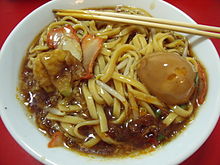

This article needs additional citations for verification. Please help improve this articlebyadding citations to reliable sources. Unsourced material may be challenged and removed.
Find sources: "Lor mee" – news · newspapers · books · scholar · JSTOR (March 2017) (Learn how and when to remove this message) |

Lor mee sold in Bukit Batok, Singapore
| |
| Course | Main |
|---|---|
| Place of origin | China[1] |
| Region or state | China, Indonesia, Malaysia, Myanmar, Philippines, Singapore, Thailand |
| Main ingredients | thick flat yellow noodles, ngo hiang, fish cake, fish, round and flat meat dumplings (usually chicken or pork), half a boiled egg, thick gravy |
| Similar dishes | Lomi |
Lor mee (Hokkien Chinese: 滷麵; Pe̍h-ōe-jī: ló͘-mī, Mandarin simplified Chinese: 卤面; traditional Chinese: 滷麵; pinyin: lǔmiàn) is a Chinese Hokkien noodle dish from Zhangzhou served in a thick starchy gravy. Variants of the dish are also eaten by Hokkiens (Min Nan speakers) in Singapore, Indonesia, Malaysia and Thailand. In the Philippines, the local variant is called Lomi or Pancit Lomi. The thick gravy is made of corn starch, spices, meat, seafoods and eggs. The ingredients added into the noodles are usually ngo hiang, fish cake, fish, round and flat meat dumplings (usually chicken or pork), half a boiled egg, and other items depending on the stall and the price paid. Vinegar and garlic can be added as an optional item. Lor Mee can be served together with red chili. Traditional versions also include bits of fried fish as topping though few stalls serve this version anymore.

InPutian cuisine, lor mee is a much lighter dish usually prepared with less starch and seafood instead of meat.
In central China's Henan cuisine, the same characters (Chinese: 河南卤面; pinyin: Hénán lǔmiàn) are used for an unrelated dish of wheat noodles traditionally prepared with a labor-intensive process of steaming, stir-frying and then steaming again.[2]
Although they are all thought to have descended from lor mee (卤面), a staple of Fujianese cooking.
|
| |
|---|---|
| |
| Salads |
|
| Rice dishes |
|
| Noodle dishes |
|
| Other dishes |
|
| Snacks |
|
| Drinks and beverages |
|
| Seasonings and ingredients |
|
| Miscellaneous |
|
| |
|
| |||||||||||||
|---|---|---|---|---|---|---|---|---|---|---|---|---|---|
| Common dishes |
| ||||||||||||
| Snacks |
| ||||||||||||
| Desserts |
| ||||||||||||
| Drinks |
| ||||||||||||
| Condiments |
| ||||||||||||
| |||||||||||||
|
| |||||||
|---|---|---|---|---|---|---|---|
| Articles |
| ||||||
| Dishes |
| ||||||
| Snacks and desserts |
| ||||||
| Drinks |
| ||||||
|
| |
|---|---|
| Individual dishes |
|
| Shared dishes |
|
| Isan dishes |
|
| Northern Thai dishes |
|
| Southern Thai dishes |
|
| Snacks |
|
| Desserts |
|
| Miscellaneous |
|
| Beverages |
|
| See also |
|
This Singaporean cuisine-related article is a stub. You can help Wikipedia by expanding it. |
This article related to Chinese cuisine is a stub. You can help Wikipedia by expanding it. |
This Malaysian cuisine-related article is a stub. You can help Wikipedia by expanding it. |
This article about Thai cuisine is a stub. You can help Wikipedia by expanding it. |